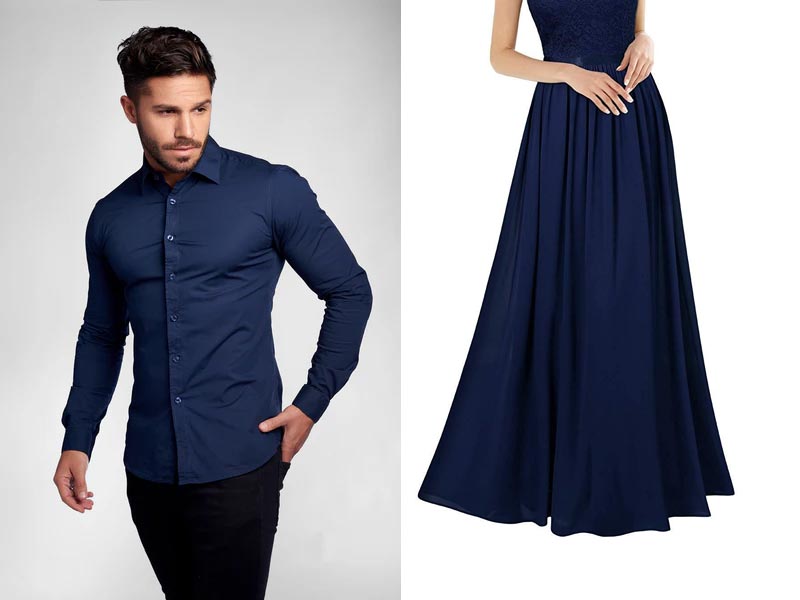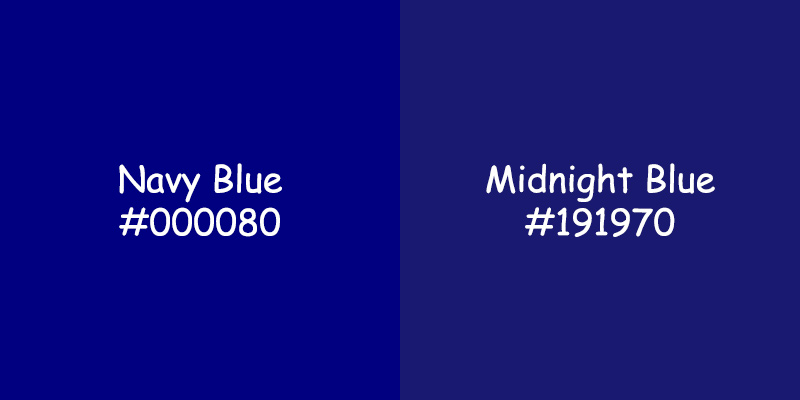Choosing the perfect shade of blue, the options seem endless. But two shades that often cause confusion are navy blue and midnight blue. While they may appear similar at first glance, there are subtle differences that set them apart.
As a color enthusiast, I’ve delved into the world of navy blue and midnight blue to uncover their unique characteristics and help you make an informed decision. In this article, I’ll explore the distinctions between these two captivating colors, their origins, and how they can be used to create stunning visual effects. So, let’s dive into the captivating world of navy blue and midnight blue and discover their true essence.
Navy blue and midnight blue are both deep, rich shades that exude elegance and sophistication. However, their undertones and origins give them distinct personalities. In this article, I’ll shed light on the origins of these colors and how they can be utilized to create striking visual impacts.
So, whether you’re contemplating a new paint color for your living room or choosing the perfect outfit for a special occasion, understanding the nuances between navy blue and midnight blue can make all the difference. Get ready to unravel the mysteries of these captivating hues and unlock their full potential.
Understanding Navy Blue and Midnight Blue
What is Navy Blue?
Navy blue is a deep, dark shade of blue that is often associated with authority, professionalism, and sophistication. It gets its name from the color worn by naval officers in many western countries. Navy blue is created by combining blue and black pigments, resulting in a rich and elegant hue.
Navy blue has a long and fascinating history. It has been used in military uniforms, maritime flags, and official insignia for centuries. Its association with the navy comes from its use in the British Royal Navy during the 18th century. Navy blue symbolized authority and command.
In addition to its historical significance, navy blue has a variety of practical applications. It is commonly used in interior design to create a sense of calmness and depth. Navy blue can be used as a statement color or as the base color in a color scheme. It pairs well with a wide range of colors, such as white, gray, and gold, making it a versatile choice for home decor and fashion.
What is Midnight Blue?
Midnight blue is another dark shade of blue that is often confused with navy blue. While similar in appearance, midnight blue has distinct characteristics that set it apart. It is a shade that is deeper, darker, and cooler than navy blue, giving it an air of mystery and elegance.
The name “midnight blue” refers to the color of the sky at midnight, when it is at its darkest. It is reminiscent of a moonlit night and is often associated with tranquility and calmness. Midnight blue is created by adding black to a pure blue shade, resulting in a deep, velvety color.
Midnight blue is a popular choice in fashion, especially for formal attire. It exudes sophistication and can add a touch of drama to any outfit. It is also commonly used in interior design to create a moody and luxurious atmosphere. Midnight blue pairs well with metallic accents, such as silver or gold, enhancing its regal and opulent qualities.
While navy blue and midnight blue are similar in their dark and rich tones, it’s important to note their subtle differences. Navy blue is slightly lighter and warmer, while midnight blue is deeper and cooler. Understanding these nuances can help you make informed decisions when choosing between the two colors for various purposes.
Now that we have explored the characteristics and practical applications of navy blue and midnight blue, let’s delve deeper into their visual effects and how they can be used to create different moods and atmospheres. But before we do that, let’s discuss the cultural significance and associations of each color.

Differences Between Navy Blue and Midnight Blue
Color Shade
When it comes to comparing navy blue and midnight blue, the first thing that comes to mind is their Color Shade. Navy blue is a deep and dark shade of blue, often associated with authority and professionalism. On the other hand, midnight blue is even deeper and darker, with a touch of coolness to it. This gives it an air of mystery and elegance that sets it apart from navy blue. While they might seem similar at first glance, the depth and cool undertones of midnight blue make it distinct.
Origins
Both navy blue and midnight blue have fascinating Origins that can help us understand their unique qualities. Navy blue gets its name from the uniforms worn by naval officers, originating in the British Royal Navy during the 18th century. Its dark hue was specifically chosen to hide stains and dirt. On the other hand, the term “midnight blue” emerged during the 1910s as a popular alternative to black in evening attire. It was inspired by the captivating darkness of the night sky.
Symbolism and Associations
The Symbolism and Associations attached to navy blue and midnight blue are worth exploring. Navy blue is often seen as a symbol of stability, authority, and trustworthiness. Its association with uniforms and prestigious institutions further reinforces its sense of power and professionalism. Midnight blue, on the other hand, is often associated with sophistication, elegance, and a sense of intrigue. Its cooler tones evoke a sense of nighttime beauty and create a captivating aura.
Usage in Fashion
Both navy blue and midnight blue are highly versatile colors and find their place in the world of fashion. While navy blue is often associated with formal attire and business suits, it has also gained popularity in casual fashion. Its timeless appeal makes it a go-to choice for various occasions.
On the other hand, midnight blue is often chosen for more formal or luxurious occasions such as evening gowns and tuxedos. Its deep and mysterious nature adds an element of sophistication and allure to any outfit.
There are subtle yet distinct differences between navy blue and midnight blue. While navy blue exudes authority and professionalism, midnight blue captivates with its deeper shade and cooler undertones. Understanding these nuances can help us make informed decisions when it comes to utilizing these colors in various settings, whether it be fashion, design, or symbolism.
Similarities Between Navy Blue and Midnight Blue
Color Composition
Both navy blue and midnight blue are members of the blue color family, characterized by their deep and rich tones. They share a common base of blue pigment, with navy blue being slightly brighter and somewhat more saturated compared to midnight blue. The darkness of both colors is achieved by incorporating darker shades of blue, as well as a touch of black.
Popularity and Versatility
Navy blue and midnight blue are highly popular and versatile colors that are widely used across various industries and sectors. These shades of blue have a timeless appeal and can effortlessly transition from season to season.
In the world of fashion, both navy blue and midnight blue are considered classic choices. They exude elegance, sophistication, and confidence, making them suitable for a range of formal and casual occasions. Navy blue is often chosen for professional attire due to its association with authority and professionalism, while midnight blue is commonly seen in luxurious evening wear and formal events.
Beyond the fashion industry, these colors have also made their mark in interior design and home decor. The deep and calming nature of navy blue and midnight blue makes them ideal choices for creating a serene and cozy atmosphere. Whether used in accent pieces or as dominant hues, both colors add a touch of elegance and style to any space.
While navy blue and midnight blue share similarities in their color composition and widespread popularity, they also possess distinct characteristics that set them apart. It’s important to understand the subtle nuances of each shade when making decisions about their use in various settings.
Conclusion
Understanding the differences between navy blue and midnight blue is crucial when it comes to making design and fashion choices. While both colors share a common base of blue pigment, navy blue stands out with its slightly brighter and more saturated hue. Navy blue is often the go-to choice for professional attire, exuding a sense of sophistication and elegance. On the other hand, midnight blue is commonly associated with luxurious evening wear, adding a touch of glamour and mystery.
Both navy blue and midnight blue are versatile shades that find their place in various industries, from fashion to interior design. Their popularity stems from their timeless appeal and ability to complement a wide range of color palettes.
However, it’s important to note that even the slightest variation in shade can create a different visual impact. So, whether you’re deciding on the color scheme for your living room or choosing the perfect dress for a special occasion, understanding the subtle nuances between navy blue and midnight blue will help you make informed decisions and create a visually stunning result.
Frequently Asked Questions
Q: What is the difference between navy blue and midnight blue?
A: Navy blue and midnight blue are both members of the blue color family, but navy blue is slightly brighter and more saturated.
Q: How are navy blue and midnight blue similar?
A: Both colors share a common base of blue pigment and are versatile, widely used in fashion and interior design.
Q: Where are navy blue and midnight blue commonly used?
A: Navy blue is often chosen for professional attire, while midnight blue is commonly seen in luxurious evening wear.
Q: Why is understanding the subtle nuances of each shade important?
A: Understanding the subtle differences between navy blue and midnight blue helps make informed decisions about their use.

2 Comments
It would have been nice to see a picture or two of the different colors for comparison.
Added